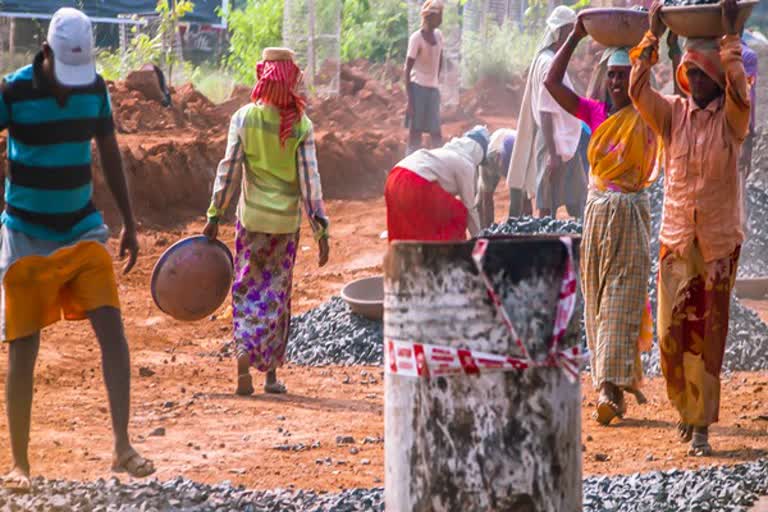Delhi: On each May 1, India along with the rest of the world celebrates May Day, also known as the International Workers’ Day, which originated in 1884 when the Federation of Organised Trades and Labour Unions of the United States and Canada demanded an eight-hour workday.
Labour Day was first celebrated in the country on May 1, 1923, on the Triplicane beach in Chennai and the celebrations were organised by the Labour Kisan Party of Hindustan, founded by Malayapuram Singaravelu Chettiar, one of the founders of the Communist Party of India.
With decades gone by since the acknowledgement of the Labour Day, to know how India's national capital, which attracts workers from all over the country, has fared so far as labour welfare is concerned, ETV Bharat visited Delhi, to speak to some of the daily wage earners and understand their working conditions.
Working on a construction site with barely any safety gear on, Raja, who hails from Bihar said, "My dreams of earning good money and save some of it have not been fulfilled. The kind of expenses that we have here, is more than what we get as wage."
Echoing his plight, another daily wage earner from Assam, who has been living in Delhi since 2001 said, "I have been sleeping on the footpath since I arrived in Delhi. Although the pay is more compared to other states, the cost of living is also very high."
When asked about the government-run shelter homes, the man said, " Those (government-run shelter homes) are no good."
Also read: Delhi govt to deduct casual leave of officials coming late to office
Delhi government and its initiatives
ETV spoke to Gopal Rai, the Minister for Employment, Development and Labour in the Delhi government run by the Aam Aadmi Party, on the steps taken by them to improve the condition of its workforce.
Rai said, "Keeping the high cost of living in mind, AAP has increased the minimum daily wage in Delhi from Rs. 9,000 to 14,000 a month, which is the highest in the country."
He further said, "We have also formulated more than 15 policies dedicated to them, be it for their medical expenses, their child's education or marriage, their pieces of equipment, their pension or accidental insurance coverage. "
"Considering the huge number of cases piling up in the Labour court (of Delhi), we have taken steps to fast track the proceedings of several cases, therefore giving relief to the labours", added Rai.
India's labour force and its plight
There are an estimated 522 million workers in India, next to China that accounts for the highest labour population as per a CIA report, with around 90 per cent of the workforce being a part of the unorganised sector. And, being a part of the unorganised sector often leaves them deprived of the benefits of various schemes started for their welfare.
A compilation of annual statistics from 13 biggest companies in India has revealed that there have been 121 industrial deaths in Financial Year 2018. The data is based on information gleaned from 19 annual filings by companies, three applications under the Right to Information (RTI) Act, and e-mails that were sent to two state-run and nine private sector companies.
Fire-related accidents, fall from a height, road accidents and truck handling were some of the common workplace hazards at these firms.
But, this data only represents the workforce in the organised sector of the country.
Another grim reminder of the dismal state of India's labour force, the country's unemployment rate was also at a 45-year-high of 6.1 per cent in 2017-18, according to the National Sample Survey Office's (NSSO's) periodic labour force survey (PLFS), which was accessed by a business newspaper early this year.
While real wages almost doubled over 18 years between 1993-94 and 2011-12 and GDP grew four-fold, low pay and wage inequality persist in India despite 7% annual average gross domestic product (GDP) growth over the past two decades, according to a new report by the International Labour Organization, a United Nations agency.
Although strong labour laws exist, in practice workers are subject to daily verbal contracts, risky occupations with no minimum protection measures, dilapidated infrastructure and obsolete tools, low daily payments or unpaid wages which can’t be claimed, the result of a network of contractors evading their responsibility: a situation, in short, characterised by instability, insecurity and uncertainty.



